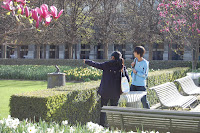On March 22, 2010, at the acclaimed
Bologna Childrens' Book Fair in Italy, Sarah read from the prototype historical itinerary of the
Time Traveler Tours,
Beware Madame La Guillotine, to rave reviews:

On the evening of 13 July 1793, I found Marat thus, in the bath at his apartment around the corner from his press. It was my third visit to his house that day. The first two times – once in the early morning, then at mid-day – I had been turned away by Simone. This time, however, I succeeded in gaining entry. I climbed the steps to Marat’s door, one heavy foot at a time, and plucked up the courage to knock yet again. I was confronted once more by a scowling and suspicious Simone, but before she could dismiss me a third time, I offered her, with a slightly trembling hand, a letter addressed to Monsieur Marat. I had written the letter myself, in the heat of the afternoon after my second failed attempt to cross his threshold. The letter stated that I had come to name names; that I was prepared to give him information regarding the missing Girondin “Enemies of the Revolution” that he sought.
Who would suspect a 24-year old girl?
Simone took the letter and shut the door with a slam, leaving me alone on that drab, inhospitable landing. I could have turned around right there and then. But Marat was just on the other side of that door. I took a long, deep breath, and held it. Would I again be turned away? If so, so be it. Or would I meet the monster Marat at last?
I met my enemy in a small, square room with a brick-tiled floor. A map of France hung upon worn wall-paper. His tub was the shape of a sabot, an old wooden shoe. A board lying across it served as a writing table so that Marat could work on his articles and conduct his interviews even while soaking. To keep warm, he sat upon a linen sheet, the dry ends covering his bare shoulders. A second sheet draped across the tub and writing table offered him a bit of privacy from his visitors.
Marat was strange and unpleasant, thin and feverish. His head was wrapped in a filthy, vinegar-soaked handkerchief. On his skin were open lesions that reeked of decaying, rotten flesh. My eyes began to tear, struggling so against the fumes of death and medicine that I did not at first notice Marat motioning me to take the chair placed beside his bath. I sat as requested, my head turned toward the window, searching the still, hot summer air for what little breeze might chance to come my way. And in the gloom of evening’s waning light, Marat took great pleasure in scribbling down one by one, his head bent over his writing table, the names of each of my beloved Girondin friends.
Once finished he raised his head, his blood-shot eyes met mine for the first time. He proclaimed viciously, hate dripping from his lips, “We’ll soon have them all guillotined in Paris!”
At that moment I knew I had justly come. I pulled out my knife and stabbed Marat right through the heart.
One blow was all it took. I felt the knife penetrate flesh, bone, muscle. It was shocking how easy it was.
Marat died almost instantly.
For more on Beware Madame La Guillotine and other tours in the Time Traveler Tours Paris series, see www.timetravelertours.com.
Image:
Baudry, Paul-Jacques-Aimé. Charlotte Corday. 1860. Musée des Beaux-Arts, Nantes.
 Okay, this is it. My last post here at FrancoFiles.blogspot.com.
Okay, this is it. My last post here at FrancoFiles.blogspot.com.











